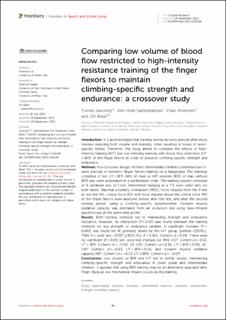| dc.description.abstract | Introduction: It is acknowledged that training during recovery periods after injury involves reducing both volume and intensity, often resulting in losses of sport-specific fitness. Therefore, this study aimed to compare the effects of high-intensity training (HIT) and low-intensity training with blood flow restriction (LIT + BFR) of the finger flexors in order to preserve climbing-specific strength and endurance. Methods: In a crossover design, thirteen intermediate climbers completed two 5-week periods of isometric finger flexors training on a hangboard. The trainings consisted of ten LIT + BFR (30% of max) or HIT sessions (60% of max without BFR) and were undertaken in a randomized order. The training session consisted of 6 unilateral sets of 1 min intermittent hanging at a 7:3 work relief ratio for both hands. Maximal voluntary contraction (MVC), force impulse from the 4 min all out test (W), critical force (CF) and force impulse above the critical force (W') of the finger flexors were assessed before, after the first, and after the second training period, using a climbing-specific dynamometer. Forearm muscle oxidative capacity was estimated from an occlusion test using near-infrared spectroscopy at the same time points. Results: Both training methods led to maintaining strength and endurance indicators, however, no interaction (P > 0.05) was found between the training methods for any strength or endurance variable. A significant increase (P = 0.002) was found for W, primarily driven by the HIT group (pretest—25078 ± 7584 N.s, post-test—27327 ± 8051 N.s, P = 0.012, Cohen's d = 0.29). There were no significant (P > 0.05) pre- post-test changes for MVC (HIT: Cohen's d = 0.13; LIT + BFR: Cohen's d = −0.10), CF (HIT: Cohen's d = 0.36; LIT + BFR = 0.05), W` (HIT: Cohen's d = −0.03, LIT + BFR = 0.12), and forearm muscle oxidative capacity (HIT: Cohen's d = −0.23; LIT + BFR: Cohen's d = −0.07). Conclusions: Low volume of BFR and HIT led to similar results, maintaining climbing-specific strength and endurance in lower grade and intermediate climbers. It appears that using BFR training may be an alternative approach after finger injury as low mechanical impact occurs during training. | en_US |

